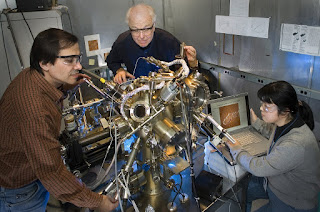"Fuel cell reactions are very demanding processes that require very pure hydrogen," said Brookhaven chemist Jose Rodriguez. "You need to find some way to eliminate the impurities, and that's where the water-gas shift reaction comes into play."
The "water-gas shift" (WGS) reaction combines CO with water to produce additional hydrogen gas and carbon dioxide. With the assistance of proper catalysts, this process can convert nearly 100 percent of the CO into carbon dioxide. Rodriguez's group, which includes researchers from Brookhaven's chemistry department,the Center for Functional Nanomaterials (CFN) , and the Central University of Venezuela, studied two "next-generation" WGS nanoscale catalysts: gold-cerium oxide and gold-titanium oxide.
"These nanomaterials have recently been reported as very efficient catalysts for the WGS reaction," said Brookhaven chemist Jan Hrbek. "This was a surprising finding because neither bulk gold nor bulk ceria and titania are active as catalysts."
To determine how these nanocatalysts work, the research team developed so-called "inverse model catalysts." The WGS catalysts usually consist of gold nanoparticles dispersed on a ceria or titania surface - a small amount of the expensive metal placed on the cheap oxide. But to get a better look at the surface interactions, the researchers placed ceria or titania nanoparticles on a pure gold surface.
"For the first time, we established that although pure gold is inert for the WGS reaction, if you put a small amount of ceria or titanium on it, it becomes extremely active," Rodriguez said. "So although these inverse catalysts are just models, they have catalytic activity comparable to, and sometimes better than, the real deal."
Using a technique called x-ray photoelectron spectroscopy at Brookhaven's National Synchrotron Light Source, as well as scanning tunneling microscopy and calculations, the researchers discovered that the catalysts' oxides are the reason for their high activity.
"The oxides have unique properties on the nanoscale and are able to break apart water molecules, which is the most difficult part of the WGS reaction," Hrbek said. Added Brookhaven physicist Ping Liu: "After you dissociate the water, the reaction continues on to eliminate CO. But if you don't have nanosized oxide particles, none of this will work."
The researchers plan to continue their study of these catalysts at the NSLS and CFN in order to further explore the reaction mechanism and optimize its performance. Funding for this research was provided by the Office of Basic Energy Sciences, within the U.S. Department of Energy's Office of Science.
The CFN is one of the five DOE Nanoscale Science Research Centers (NSRCs), premier national user facilities for interdisciplinary research at the nanoscale. Together the NSRCs comprise a suite of complementary facilities that provide researchers with state-of-the-art capabilities to fabricate, process, characterize, and model nanoscale materials, and constitute the largest infrastructure investment of the National Nanotechnology Initiative. The NSRCs are located at DOE's Brookhaven, Argonne, Lawrence Berkeley, Oak Ridge, and Sandia and Los Alamos National Laboratories. For more information about the DOE NSRCs, please visit nano.energy.gov/.
Written by Kendra Snyder Contact: Karen McNulty Walsh kmcnulty@bnl.gov 631-344-8350 DOE/Brookhaven National Laboratory
Technorati Tags: Nano or Nanotechnology and Nanotech and or Brookhaven National Laboratory and Fuel Cell Catalysts or President and Mrs. Bush Wish Americans, Troops Happy New Year and Short-horned Lizard (Phrynosoma douglassii) and 'the right glasses' for observing mystery behavior in electrons















No comments:
Post a Comment